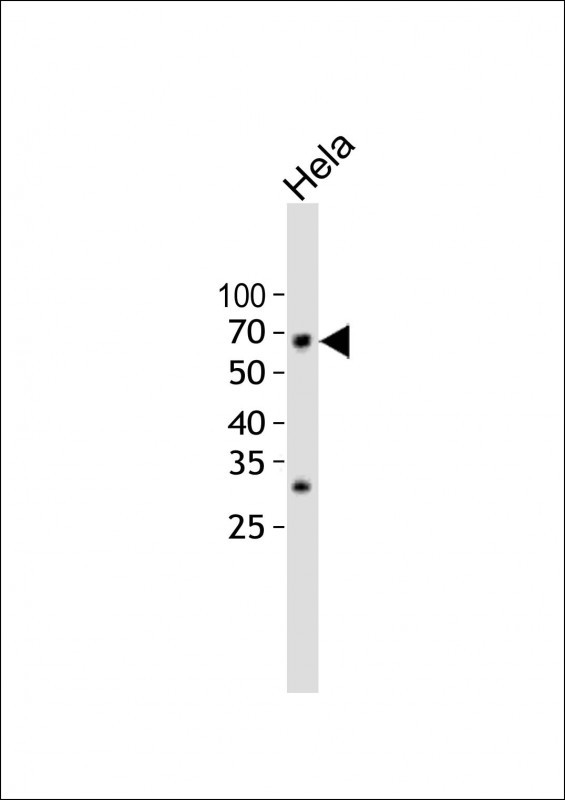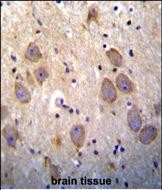cIAP2 (BIRC3) Antibody (N-term)
Affinity Purified Rabbit Polyclonal Antibody (Pab)
- 产品详情
- 文献引用 : 2
- 实验流程
- 背景知识
Application
| WB, IHC-P, E |
|---|---|
| Primary Accession | Q13489 |
| Other Accession | NP_892007 |
| Reactivity | Human |
| Host | Rabbit |
| Clonality | Polyclonal |
| Isotype | Rabbit IgG |
| Calculated MW | 68372 Da |
| Antigen Region | 101-131 aa |
| Gene ID | 330 |
|---|---|
| Other Names | Baculoviral IAP repeat-containing protein 3, 632-, Apoptosis inhibitor 2, API2, C-IAP2, IAP homolog C, Inhibitor of apoptosis protein 1, IAP-1, hIAP-1, hIAP1, RING finger protein 49, TNFR2-TRAF-signaling complex protein 1, BIRC3, API2, IAP1, MIHC, RNF49 |
| Target/Specificity | This cIAP2 (BIRC3) antibody is generated from rabbits immunized with a KLH conjugated synthetic peptide between 101-131 amino acids from the N-terminal region of human cIAP2 (BIRC3). |
| Dilution | WB~~1:500 IHC-P~~1:100~500 E~~Use at an assay dependent concentration. |
| Format | Purified polyclonal antibody supplied in PBS with 0.05% (V/V) Proclin 300. This antibody is purified through a protein A column, followed by peptide affinity purification. |
| Storage | Maintain refrigerated at 2-8°C for up to 2 weeks. For long term storage store at -20°C in small aliquots to prevent freeze-thaw cycles. |
| Precautions | cIAP2 (BIRC3) Antibody (N-term) is for research use only and not for use in diagnostic or therapeutic procedures. |
| Name | BIRC3 |
|---|---|
| Synonyms | API2, MIHC, RNF49 |
| Function | Multi-functional protein which regulates not only caspases and apoptosis, but also modulates inflammatory signaling and immunity, mitogenic kinase signaling and cell proliferation, as well as cell invasion and metastasis. Acts as an E3 ubiquitin-protein ligase regulating NF-kappa-B signaling and regulates both canonical and non- canonical NF-kappa-B signaling by acting in opposite directions: acts as a positive regulator of the canonical pathway and suppresses constitutive activation of non-canonical NF-kappa-B signaling. The target proteins for its E3 ubiquitin-protein ligase activity include: RIPK1, RIPK2, RIPK3, RIPK4, CASP3, CASP7, CASP8, IKBKE, TRAF1, and BCL10. Acts as an important regulator of innate immune signaling via regulation of Toll-like receptors (TLRs), Nodlike receptors (NLRs) and RIG-I like receptors (RLRs), collectively referred to as pattern recognition receptors (PRRs). Protects cells from spontaneous formation of the ripoptosome, a large multi-protein complex that has the capability to kill cancer cells in a caspase-dependent and caspase- independent manner. Suppresses ripoptosome formation by ubiquitinating RIPK1 and CASP8. |
| Cellular Location | Cytoplasm. Nucleus |
| Tissue Location | Highly expressed in fetal lung, and kidney. In the adult, expression is mainly seen in lymphoid tissues, including spleen, thymus and peripheral blood lymphocytes |
For Research Use Only. Not For Use In Diagnostic Procedures.

Provided below are standard protocols that you may find useful for product applications.
BACKGROUND
BIRC3 is a member of a family of proteins that inhibits apoptosis by binding to tumor necrosis factor receptor-associated factors TRAF1 and TRAF2, probably by interfering with activation of ICE-like proteases. The encoded protein inhibits apoptosis induced by serum deprivation but does not affect apoptosis resulting from exposure to menadione, a potent inducer of free radicals. The amino acid sequence predicts three baculovirus IAP repeat domains and a ring finger domain.
REFERENCES
Wang, Q., et al., J. Biol. Chem. 278(51):51091-51099 (2003).
Suguro-Katayama, M., et al., Leukemia 17(12):2508-2512 (2003).
Jonsson, G., et al., Anticancer Res. 23(4):3311-3316 (2003).
Yang, Q.H., et al., Genes Dev. 17(12):1487-1496 (2003).
Dai, Z., et al., Hum. Mol. Genet. 12(7):791-801 (2003).
终于等到您。ABCEPTA(百远生物)抗体产品。
点击下方“我要评价 ”按钮提交您的反馈信息,您的反馈和评价是我们最宝贵的财富之一,
我们将在1-3个工作日内处理您的反馈信息。
如有疑问,联系:0512-88856768 tech-china@abcepta.com.






















 癌症的基本特征包括细胞增殖、血管生成、迁移、凋亡逃避机制和细胞永生等。找到癌症发生过程中这些通路的关键标记物和对应的抗体用于检测至关重要。
癌症的基本特征包括细胞增殖、血管生成、迁移、凋亡逃避机制和细胞永生等。找到癌症发生过程中这些通路的关键标记物和对应的抗体用于检测至关重要。 为您推荐一个泛素化位点预测神器——泛素化分析工具,可以为您的蛋白的泛素化位点作出预测和评分。
为您推荐一个泛素化位点预测神器——泛素化分析工具,可以为您的蛋白的泛素化位点作出预测和评分。 细胞自噬受体图形绘图工具为你的蛋白的细胞受体结合位点作出预测和评分,识别结合到自噬通路中的蛋白是非常重要的,便于让我们理解自噬在正常生理、病理过程中的作用,如发育、细胞分化、神经退化性疾病、压力条件下、感染和癌症。
细胞自噬受体图形绘图工具为你的蛋白的细胞受体结合位点作出预测和评分,识别结合到自噬通路中的蛋白是非常重要的,便于让我们理解自噬在正常生理、病理过程中的作用,如发育、细胞分化、神经退化性疾病、压力条件下、感染和癌症。







